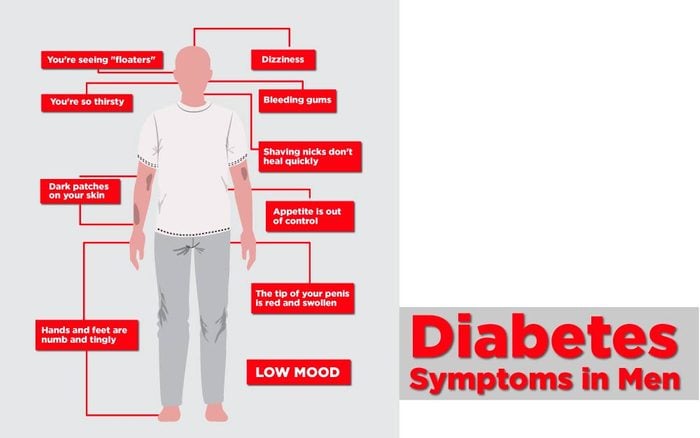10 Diabetes Symptoms in Men Every Man Should Be Aware Of
Updated: Oct. 11, 2022

An astounding one in four Americans who have diabetes don't know it. Here are some symptoms you need to watch out for whether you suspect you have the condition or already know you do.
You notice dark patches on your skin
Your skin is a window into the health of your insides—check out all the conditions your skin can reveal. Type 2 diabetes is no exception. The back of your neck, groin, or underarms may look “dirty,” but the dark, velvety patches in these areas are actually a symptom of insulin resistance, which is a hallmark of type 2 diabetes, the most common type of diabetes. The skin condition is called acanthosis nigricans (AN), and it can happen in men, women, and even children. “The hormones involved in insulin resistance are also thought to contribute to the skin condition,” says Margaret Eckert-Norton, PhD, RN, associate professor at St. Joseph’s College in New York City. “It’s something that tends to happen gradually over the years.” Treatment for AN involves addressing the underlying cause—in this case, regaining control over blood sugar levels. If you are at risk for or have type 2 diabetes, check out the steps doctors take to get better control over their blood sugar.
The tip of your penis is red and swollen
There are many warning signs that you could be developing type 2 diabetes, including erectile dysfunction. According to a study published in a 2017 issue of The Consultant Pharmacist, a condition called balanitis, inflammation of the penis, may be the first recognition of previously undiagnosed type 2 diabetes in older men. Symptoms include swelling of the foreskin and tip of the penis, and it may be painful or you could experience a discharge. See your doctor, who will instruct you on the best way to keep the area clean and may recommend treatment with an anti-fungal or antibiotic cream (depending on the source of the problem). In women, type 2 diabetes is linked to a higher risk of yeast infections.
Shaving nicks don’t heal quickly
While shaving your face you get a tiny cut that seems to linger forever. “When your sugars are on their way up, it may take longer for a cut to heal,” explains Eckert-Norton. You may also notice more shaving bumps and whiteheads in your hair follicles in your beard. The sebaceous oil glands in your face are also vulnerable to low-grade infections that you’re at risk for when you have type 2 diabetes, she says. Check out these smart and safe hygiene habits all men should follow.
Your hands and feet are numb and tingly
One common complication of type 2 diabetes is a condition called peripheral neuropathy, nerve damage that affects the feet and legs and sometimes the hands and arms. About one-third to one-half of people with diabetes have this type of neuropathy, and it can happen in men and women. Eckert-Norton says that it presents in a “stocking, glove” pattern. “Where your socks go on, peripheral neuropathy happens first, and it eventually gets to your fingertips later on,” she says. Keeping blood glucose levels on target is key to lessening pain and numbness. Wearing the best diabetic shoes for men will help, too.
You’re so thirsty
Thirst is common with type 2 diabetes in both men and women—in fact, it can be a sign of at least eight medical problems. You may notice that no amount of water can quench your thirst. That’s due to rising blood sugar levels, which forces your kidneys to get hard at work trying to filter out the excess sugar by ramping up urine production, says Eckert-Norton. You’ll pee more, which can potentially lead to dehydration, and you’ll want to drink more, too. If you notice that you’re running to the bathroom all day or are excessively thirsty (or dealing with a dry mouth), talk to your doctor about your glucose levels.
You’re seeing “floaters”
Though uncontrolled diabetes can damage eyes, it’s usually not until diabetes is more advanced that you start experiencing symptoms. Over time, high blood sugar damages blood vessels in the retina, causing them to bleed and leading to diabetic retinopathy, according to the National Eye Institute. You may notice black floating spots dotting your field of vision. Dramatic changes in glucose levels can also blur your vision. If you notice these type 2 diabetes symptoms, see a doctor for a dilated eye exam. Both men and women who have been diagnosed with diabetes need an eye exam at least once a year to ensure eyes stay healthy.
Your appetite is out of control
If you inexplicably have an enormous appetite, it may be a symptom of type 2 diabetes. Insulin resistance means it’s harder for the body to shuttle glucose into cells where it produces energy. As a response, your body also produces more insulin, and that ramps up your appetite and triggers cravings. This is also how weight gain happens, Eckert-Norton explains. She adds that some patients will keep candy bars in their desks to pull out when they feel like they have low blood sugar. The problem is, it’s easy to overcompensate by eating too much—and the wrong types of foods (see: candy bar). Along with seeing your doctor, there are 19 strategies you can try to keep hunger at bay.
Your mood is low
Among the problems triggered by poor blood sugar, mood disorders are notorious. And a study published in 2017 in Diabetes Care showed that men with type 2 diabetes had a higher risk of early death due to depression and anxiety compared to women with type 2 (although both men and women can have a higher risk of depression). While having a chronic condition can also increase your risk of depression, it’s thought that the condition itself is partly to blame. When blood sugar is high, fatigue occurs and this can resemble depression too. Depression is often missed in type 2 diabetes patients, but therapy and antidepressants may help.
Your gums are bleeding
You’ve heard that one reason to stay on top of your oral health is because gum problems can put you at risk for chronic diseases like heart disease. Your teeth can reveal a lot of issues with your body, and one of those issues is diabetes. People with diabetes are three times more likely to develop periodontitis (an infection that damages gums and can lead to tooth loss) compared to those who don’t have the disease. A study published in 2014 in Diabetes & Metabolic Syndrome shows that diabetes raises the risk of red, swollen, and bleeding gums, all signs of periodontitis.
You’re dizzy
When you’re thinking about possible diabetes symptoms, balance issues may not come to mind. They should—in fact, there are at least 8 medical reasons you might feel dizzy. Inner ear disorders, which can show up as dizziness and balance problems, are 70 percent more common in people with diabetes than in those who don’t have the condition, according to a study published in 2016 in the journal Physical Therapy. Diabetes damages small blood vessels, which may, in turn, affect the blood flow to the inner ear structures. In addition, dehydration can make you feel dizzy and nerve damage in the feet due to peripheral neuropathy can also cause balance problems. The lesson: Even seemingly unrelated problems can be a clue that your blood sugar levels are on the rise.

